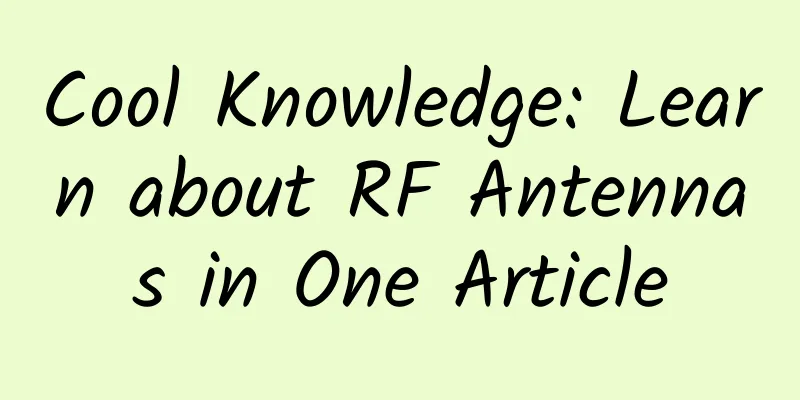Cool Knowledge: Learn about RF Antennas in One Article

RF Antennapicture An antenna is a device used to receive or send radio signals. It can be an antenna used to receive radio waves or an antenna used to send radio waves. There are many types of antennas, the most common ones are dipole antennas, directional antennas, antenna arrays, etc. In the field of communications, antennas play a very important role, which directly affects the transmission quality and distance of wireless signals. DirectionalityThe directivity of an antenna is its ability to receive or transmit wireless signals in different directions. An antenna with strong directivity has higher gain in a specific direction and lower gain in other directions. The directivity of an antenna is usually described by a directivity diagram, which shows the radiation pattern of the antenna in different directions. picture In antenna engineering, commonly used directivity parameters include main lobe width, side lobe horizontal and vertical angles, front-to-back ratio, etc. These parameters can help engineers evaluate the performance of antennas in different directions and thus select suitable antennas for specific application scenarios. The directivity of an antenna can be expressed as:
VSWRThe antenna's standing wave ratio (SWR) is one of the important indicators for measuring antenna performance. It is an indication of the impedance matching at the antenna input, and can also reflect the antenna's radiation efficiency and performance stability. The standing wave ratio of the antenna can be calculated by the following formula: [ SWR = \frac{Z_{\text{max}}}{Z_{\text{min}}} ] where (Z_{\text{max}}) is the maximum impedance at the antenna input and (Z_{\text{min}}) is the minimum impedance at the antenna input. Normally, the ideal standing wave ratio of an antenna is 1, indicating that the impedance at the antenna input is completely matched and there is no reflected wave. When the standing wave ratio is greater than 1, it indicates that there is an impedance mismatch, which will cause partial reflection of the signal and affect the performance of the antenna. dB, dBm, dBi
The gain is calculated as: [ \text{Gain} = 10 \log_{10} \left( \frac{P_{\text{out}}}{P_{\text{in}}} \right) ] where ( P_{\text{out}} ) is the output power and ( P_{\text{in}} ) is the input power. picture db is a relative value, dbm is an absolute value picture picture Directionality EnhancementAntenna directivity enhancement is the ability of the antenna to radiate more strongly in a specific direction than in other directions. This is usually achieved by changing the structure or design of the antenna to obtain stronger signal transmission or reception capabilities in a specific direction. picture In antenna design, common methods include using directional antennas (such as directional antennas, feed antennas, etc.), array antennas (such as linear arrays, planar arrays, etc.) or enhancing directivity through the shape and size of the antenna. In wireless communications, enhancing the directivity of antennas can help reduce interference, improve signal coverage, increase communication distance, etc., so it is of great significance in practical applications. Mathematically, the directivity enhancement of an antenna can be described by the antenna's radiation pattern, which shows the distribution of the radiated power density of the antenna in different directions. Generally speaking, an antenna with enhanced directivity will have a higher radiated power density in the main lobe direction and a lower radiated power density in the side lobe direction. picture Beam widthBeamwidth is usually used to describe the propagation characteristics of electromagnetic waves or sound waves. In wireless communications, beamwidth refers to the coverage of electromagnetic waves radiated by an antenna in space. In acoustics, beamwidth refers to the propagation range of sound waves in space. picture The beam width can be expressed by the following formula: [ \theta = \frac{c}{D} ] Where θ is the beam width, c is the wave speed, and D is the diameter or length of the antenna or sound source. picture bandwidthAntenna bandwidth is the frequency range in which an antenna can operate effectively. In wireless communications, the bandwidth of an antenna determines the range in which it can receive and send signals. Antenna bandwidth is usually expressed in Hertz (Hz) and depends on the design and materials of the antenna, as well as the choice of operating frequency. The size of the antenna bandwidth directly affects the performance and coverage of the communication system. picture Whether it is a transmitting antenna or a receiving antenna, they always work within a certain frequency range. Usually, the power that the antenna can transmit is the largest when working at the center frequency. When it deviates from the center frequency, the power it transmits will decrease. The frequency bandwidth of the antenna can be defined based on this. Feeder attenuation coefficientThe feeder attenuation coefficient is usually represented by \alpha, which is a parameter that measures the degree of signal attenuation during transmission. The attenuation coefficient is related to the characteristics of the transmission medium and the frequency of the signal. In general, the attenuation coefficient is proportional to the transmission distance. The longer the transmission distance, the more severe the attenuation. The attenuation coefficient can be calculated by the following formula: \alpha = \frac{10}{L} \log_{10} \left( \frac{P_{\text{in}}}{P_{\text{out}}} \right) Among them, \alpha represents the attenuation coefficient, L represents the transmission distance, P_{\text{in}} represents the input power, and P_{\text{out}} represents the output power For example, the attenuation coefficient of the ordinary non-low-loss cable SYV-9-50-1 at 900MHz is β = 20.1dB / 100m, which can also be written as β = 3dB / 15m. That is to say, the signal power with a frequency of 900MHz will be reduced by half every time it passes through 15m of this cable. Feeder MatchingFeeder matching is to match the impedance of the feeder with its operating frequency to ensure maximum signal transmission and minimum loss. Feeder matching can be achieved by adjusting the characteristic impedance of the feeder. Common matching methods include using impedance transformers, matching networks, or adjusting the length and width of the feeder. In microwave and RF engineering, feeder matching is very important, because poor matching will lead to signal reflection and loss, affecting system performance. Therefore, designing and implementing good feeder matching is a key step to ensure system performance. picture In actual work, the input impedance of the antenna will also be affected by the surrounding objects. In order to make the feeder and the antenna match well, it is also necessary to measure and appropriately adjust the antenna structure or install a matching device when setting up the antenna. Feeder reflection lossIt has been pointed out before that when the feeder and antenna are matched, there is no reflected wave on the feeder, only incident wave, and the wave transmitted on the feeder is a traveling wave. At this time, the voltage amplitude and current amplitude at each point on the feeder are equal, and the impedance at any point on the feeder is equal to its characteristic impedance. When the antenna and feeder do not match, that is, when the antenna impedance is not equal to the characteristic impedance of the feeder, the load can only absorb part of the high-frequency energy transmitted on the feeder, but not all of it. The unabsorbed energy will be reflected back to form a reflected wave. picture The reflection loss of the feeder can be calculated by the following formula: [ \text{Reflection loss (dB)} = -20 \log_{10} | \Gamma | ] Where ( \Gamma ) represents the reflection coefficient, which can be calculated by the following formula: [ \Gamma = \frac{Z_L - Z_0}{Z_L + Z_0} ] Where ( Z_L ) is the impedance of the load and ( Z_0 ) is the characteristic impedance of the feeder. Antenna gainAntenna gain is usually expressed in dBi (dB isotropic), which is the gain of the antenna relative to an ideal isotropic antenna. Antenna gain can be expressed by the following formula: [ \text{Gain (dBi)} = 10 \times \log_{10} \left( \frac{\text{RPD}}{\text{RPIS}} \right) ] RPD is the radiated power of an antenna in a specific direction, and RPIS is the radiated power of an isotropic antenna. picture Gain refers to the ratio of the square of the field strength generated by the actual antenna and the ideal radiating unit at the same point in space under the condition of equal input power, that is, the power ratio. Gain is generally related to the antenna radiation pattern. The narrower the main lobe of the radiation pattern, the smaller the back lobe and side lobe, and the higher the gain. Industry knowledge standardsThe 50 ohms of a 50 ohm transmission line refers to its characteristic impedance. Characteristic impedance is a concept of electromagnetic waveguide. Ideally, the calculation of characteristic impedance does not need to consider the conductivity of the material, but rather assumes that the material is an ideal conductor with infinite conductivity. The current only flows on the surface of the material (here, the outer surface of the coaxial cable core and the inner surface of the shielding layer), and the current flows on the conductor without resistance and loss. Characteristic impedance is not resistance, but the ratio of the inductive reactance to the capacitive reactance of the transmission line. It has nothing to do with the length and is only related to the structure and insulation material. Long cables do have resistance that will cause signal attenuation, but it will not change the waveform and standing wave ratio. 50 ohm corrugated copper tube coaxial cable is mainly used for ground mobile communications and radio communication antenna feeders, antenna jumpers for ground base stations, feeders and antenna connecting lines for machine rooms, military data information transmission lines, ultra-low frequency, AM and FM radio broadcasting systems, ground microwave communications, aviation and navigation radar systems, strategic and other portable communication systems, etc. picture 50 ohm braided coaxial cable has excellent electrical properties, its braided structure is softer and very convenient to construct. It is commonly used in ground mobile communication and radio communication antenna feeder, ground base station antenna jumper, machine room feeder and antenna connection line, military data information transmission line, ultra-low frequency, AM and FM radio broadcasting system, ground microwave communication system, aviation and navigation radar system and strategic portable communication system, etc. picture SummarizeAntennas are devices used to send or receive radio waves. They can convert electrical energy into radio waves or vice versa. The design and selection of antennas are critical to the performance of wireless communication systems. Antenna gain refers to the radiated power gain of an antenna in a specific direction relative to an ideal point source antenna. It refers to the gain of an antenna in a specific direction relative to omnidirectional radiation. Antenna gain is usually expressed in decibels (dB). The characteristics of the antenna include frequency response, radiation pattern, polarization, bandwidth, standing wave ratio, etc. These characteristics determine the performance of the antenna under different working conditions. The feeder is a conductor that connects the antenna and the radio equipment. Common feeder materials include copper, aluminum, coaxial cable, etc. Different materials will affect the transmission loss, impedance matching and other performance of the feeder. In antenna design and application, some industry standards are widely adopted, such as standard documents issued by organizations such as IEEE and ITU. These standard documents contain specifications and guidance for antenna design, testing, and application. |
<<: Thoroughly understand Session and Token
>>: Why is the 5G signal weaker than 4G?
Recommend
Accelerating digital transformation, 5G empowers the next generation of new industrial manufacturing
[[335662]] The COVID-19 pandemic has imposed mand...
WiFi 7 for ubiquitous access
It is now common to use mobile communication netw...
In-depth analysis of the operation results of Go Channel in each state
Hello everyone, I am Fisherman. Channel is a uniq...
edgeNAT April Fools' Day event offers 30% off monthly payment and 40% off annual payment, Korean/US/Hong Kong VPS starts from 42 yuan per month
Today is April Fools' Day, but the promotion ...
VMISS newly launched Hong Kong BGPV3 node, 20% off, starting from 21 yuan/month, optional CN2 GIA/9929/CMIN2, etc.
VMISS has newly launched the Hong Kong BGP V3 nod...
Ten times faster than 5G? What is the future of 10G network?
In the digital age, how to use technology to prom...
United States: Suspend 5G deployment!
[[442701]] As we all know, spectrum resources are...
CAICT answers hot issues on “number portability” service
On November 27, 2019, China Telecom, China Mobile...
7 pictures to help you understand the difference between HTTP and HTTPS!
1. Introduction to HTTP Protocol 👨🏫 Interviewer:...
NWCU's Smart New Campus 2.0, layout of "IT unified smart operation and maintenance" (Part 2): operation and maintenance organization management and process management
Xi’an University of Architecture and Technology i...
Fiber-optic interconnects: How to improve cloud computing networks
Since the beginning of the 21st century, cloud co...
Huawei and China Telecom jointly release innovative results of "Cloud Network Core Capabilities", leading a new paradigm of strategic cooperation
On March 1, during MWC22 Barcelona, Huawei and ...
What technical support is needed to build a fixed network architecture based on SDN/NFV?
As of the end of October 2016, the number of Chin...
The Difference Between a Network Hub and a Network Switch
What is a Network Hub? A hub in a computer networ...









![[Black Friday] CMIVPS Hong Kong VPS Hosting 30% off, Hong Kong/US Dedicated Server 10% off](/upload/images/67cac4922b03f.webp)